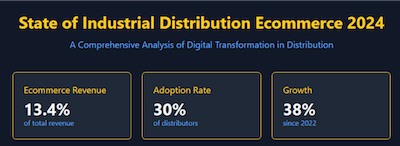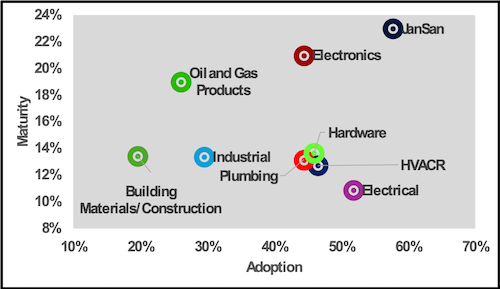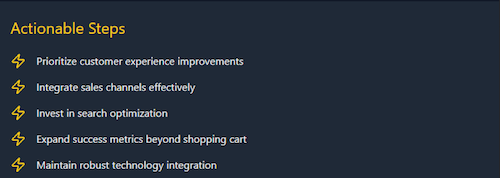The state of e-commerce in industrial distribution: 2024 insights and strategies
By Jonathan Bein
The industrial distribution sector is undergoing a significant digital transformation fueled by evolving customer expectations and technological advancements. Insights from the 2024 State of E-commerce Study by Distribution Strategy Group highlight essential trends and strategies for distributors to succeed in this environment.
Industrial Distribution’s E-commerce Performance
 E-commerce now accounts for 13.4% of total revenue in 2024, a 38% growth since 2022. This figure, focused on shopping cart transactions, excludes other digital channels such as EDI, punchout catalogs, and email orders. Larger distributors ($100M+) lead with 16% of revenue from e-commerce, compared to 10% for smaller companies. However, complexities in industrial products and transactions continue to challenge broader adoption.
E-commerce now accounts for 13.4% of total revenue in 2024, a 38% growth since 2022. This figure, focused on shopping cart transactions, excludes other digital channels such as EDI, punchout catalogs, and email orders. Larger distributors ($100M+) lead with 16% of revenue from e-commerce, compared to 10% for smaller companies. However, complexities in industrial products and transactions continue to challenge broader adoption.
Key Drivers of Growth
Customer Experience (CX): Customer experience is a priority for 57% of distributors. Investments target tools for seamless product discovery, enhanced technical content, streamlined checkout, and mobile-friendly interfaces. Integration with procurement systems further supports on-the-go users.
 Field Sales Integration: Field sales teams play a pivotal role, with 56% of respondents acknowledging their contributions to e-commerce adoption. Their efforts include educating customers, demonstrating online platforms, and resolving technical queries.
Field Sales Integration: Field sales teams play a pivotal role, with 56% of respondents acknowledging their contributions to e-commerce adoption. Their efforts include educating customers, demonstrating online platforms, and resolving technical queries.
Search Engine Optimization (SEO): SEO has emerged as a vital driver, with 27% ranking it among their top marketing strategies. Improved organic search rankings and keyword optimization are boosting online visibility and traffic.
[Insert Graphic 2]
Financial Objectives and Strategies
Distributors are focusing on deepening relationships within existing markets. Their main objectives include:
- Growing revenue from current customers (59%).
- Increasing average transaction sizes (55%).
- Enhancing order frequency (54%).
- Attracting new customers in established markets (49%).
- The Role of Technology
- Technology integration is a cornerstone of successful e-commerce. High-performing distributors leverage:
- ERP-integrated e-commerce platforms.
- Advanced product data management systems.
- AI tools for personalized recommendations and enhanced search functionalities.
These technologies enable a seamless, multi-channel customer experience while optimizing operational efficiency.
Challenges in Industrial E-commerce
Product Complexity. Industrial products often require detailed specifications and customization. Successful strategies include using advanced configurators, enriched product content, and hybrid service models blending digital and personal support.
Transaction Complexity. Complex workflows involving approvals, and special pricing requires integration with procurement systems and customizable pricing engines. Leading distributors address these issues through flexible digital solutions.
Customer Buying Processes. Rigid purchasing practices necessitate a hybrid approach, combining robust digital tools with strong personal relationships.
Measuring Success
Shopping cart transactions account for only 18% of digitally influenced sales, while website research affects 5%–15% of offline purchases. Approximately 60% of all interactions involve digital tools, prompting distributors to develop more comprehensive ROI models that reflect the broader impact of e-commerce.
Recommendations for Industrial Distributors
Distributors aiming to enhance customer experience should prioritize improvements in (1) search functionalities, (2) streamlined ordering processes, and (3) mobile optimization to boost usability and overall satisfaction.
Integrating sales channels is another crucial strategy. Field sales teams must be equipped with the necessary knowledge and tools to support hybrid purchasing behaviors and foster digital adoption among customers.
Investing in SEO is also vital. Allocating resources to improve organic search performance, optimize keywords, and analyze conversion metrics can significantly enhance online visibility and drive traffic. Additionally, adopting comprehensive metrics allows distributors to measure success more effectively by incorporating website-influenced offline sales and multi-channel purchasing patterns into their evaluations.
Finally, leveraging technology remains a cornerstone of e-commerce success. Distributors should fully integrate their e-commerce platforms with ERP and other core systems to ensure operational efficiency and deliver seamless customer experience.
 Emerging Trends and Insights
Emerging Trends and Insights
Digital marketing in industrial distribution is evolving. Key trends include:
- Increased reliance on SEO for demand generation.
- Continued use of email marketing.
- Limited effectiveness of social media for B2B contexts.
Larger customers demand greater technical support and digital tools, while smaller customers prioritize pricing transparency and simpler ordering methods. Satisfaction with e-commerce investments has risen to 23%, driven by higher revenue contributions and effective CX enhancements.
Conclusion
The 2024 State of Ecommerce Study underscores the industrial distribution sector’s transition toward a digitally integrated model. By combining traditional strengths with advanced digital capabilities, distributors can deliver exceptional customer experiences and position themselves for success. Embracing technology, refining measurement systems, and prioritizing customer needs will enable them to thrive in an increasingly competitive market.

Jonathan Bein is managing partner at Distribution Strategy Group. He can be reached at jbein@distributionstrategy.com.













